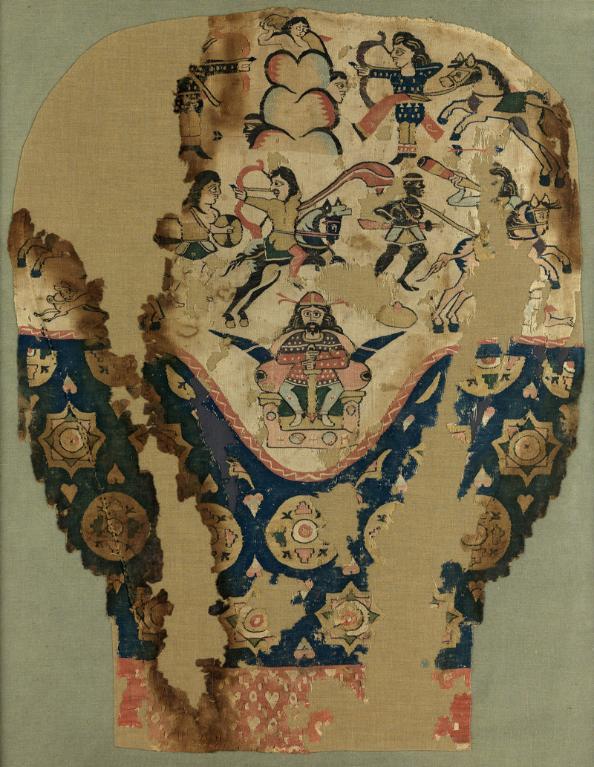Shop Amazon - Create an Amazon Baby Registry

Shop Amazon - Create an Amazon Baby Registry
A battle between Arabs, Persians and Ethiopians & enthroned ruler
Coptic textile fragment of legging, Egypt, late 6th or early 7th century, Musée des Tissus, Lyon, France

A larger image of a battle between Arabs, Persians and Ethiopians, Coptic textile fragment of legging, Egypt, Musee des Tissus
Photo © Musée des Tissus, Pierre Verrier
Jambière historiée
Tapisserie, armure toile, dominante trame, à relais, duites courbes et ressauts. Laine.
H. 71 cm, l. 53 cm (laize) ; H. 80 cm, l. 67 cm (monté)
Antinoé, fouilles Albert Gayet, treizième campagne, 1908 , deuxième quart du VIe siècle-deuxième quart du VIIe siècle.
MT 28928.
Historiated legging.
Tapestry weave, dominant frame relay, picks curves and jumps. Wool.
Height 71 cm , Width 53 cm; H. 80 cm, W. 67 cm (mounted)
Antinoe, Albert Gayet excavations, thirteenth year, 1908, second quarter of the sixth century-second quarter of the seventh century
MT 28928.
Examination of this and a legging now in the Louvre (inv. E 29323),
woven identically, can reconstruct the scene as a whole.
The figured scene indeed occupies the upper part between the rounded summit and a pink band covered with a white zigzag halfway down.
Eleven people, five horses and a dog have a place in a scholarly composition adapted for this small space.
Symmetry provides the necessary clarity while the diverse attitudes of warriors suggest the movements of the warlike action.
The forces are unequal; horse-archers easily triumph over their infantry opponents, armed with stones.
In this group, some have light skin while others are black.
The victory was proclaimed by a trumpet rider trampling an enemy and leading a prisoner at the end of a rope. In the centre of the legging is enhroned an important person.
The pink band boundary bends flexibly to leave the place of honor. It is undoubtedly the potentate of the victorious army.
Its iconography combines Byzantine features (throne cabochons, cushion) to the clichés of Sassanid Persia (costume, face posture, sword outstretched in front of you).
Musée des Tissus. MT 28928.
The "King" has generated many comments on the battle represented. A historic event has been advanced: the war waged by the Sassanid king Chosroes I against Arabs and Abyssinians.
The fighting took place in Yemen in 570 AD.
Referenced on p.53, EH - 071 - The Great Islamic Conquests AD 632-750 by David Nicolle
A battle between Arabs, Persians and probably Ethiopians, depicted on a Coptic textile fragment from Egypt, late 6th or early 7th century.
The subject is so unusual for a textile woven in early Christian Egypt that it may have been made during the brief Sassanian occupation at the start of the 7th century,
or shortly after Egypt fell under Arab-Islamic rule. The fact that the horseman in the centre appears to be using stirrups would suggest the latter date.
(Musee des Tissus, Lyon, France)
A Coptic textile from Antinoë, repeatedly cited as Sasanian in style, has as part of its design an enthroned figure.116
The pose of the enthroned figure is admittedly the same as that on Sasanian works of art. He sits full-front, holding a sword between splayed legs, but neither his dress nor his throne seat in any way reflect Sasanian types.
116. Musée Historique des Tissus, Lyons, inv. no. 28.928; height 80 cm.; width 66cm. Ghirshman, Persian Art, p. 236, fig. 289; Koptische Kunst, p. 344, no. 368; Peirce and Tyler, L'Art byzantin 1, pp. 87 ff., pls. 55, 56; Francovich, "II concetto della regalità," p. 25. The fabric is said to be copied from Sasanian works.
Source: p.121, Harper, Prudence and Meyers, Pieter Silver Vessels of the Sasanian Period. Volume One: Royal Imagery, The Metropolitan Museum of Art, Princeton University Press, New York, 1981
See also A battle between Arabs, Persians and Ethiopians & enthroned ruler. Coptic textile fragment of legging, Egypt, late 6th or early 7th century, Louvre, Paris, France
Plates with figures from Persia and Central Asia and bowls, cups, cameos, plaques, paintings, reliefs and textiles with similar iconography.
Coptic Egyptian Carved Limestone Relief of Horse and Camel Riders, 6th century, Coptic Museum, inv. 8001, Cairo
Illustrations of Costume and Soldiers from Coptic and Nubian sources
Other 6th Century Illustrations of Costume & Soldiers

